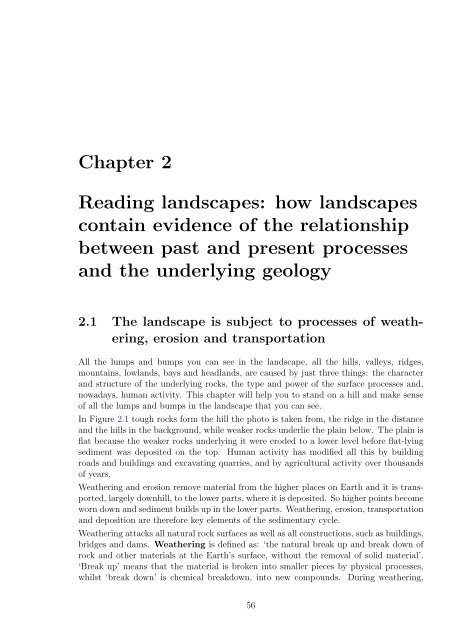The planet we live on: The beginnings of the Earth Sciences
The planet we live on: The beginnings of the Earth Sciences
The planet we live on: The beginnings of the Earth Sciences
- No tags were found...
You also want an ePaper? Increase the reach of your titles
YUMPU automatically turns print PDFs into web optimized ePapers that Google loves.
Chapter 2Reading landscapes: how landscapesc<strong>on</strong>tain evidence <strong>of</strong> <strong>the</strong> relati<strong>on</strong>shipbet<str<strong>on</strong>g>we</str<strong>on</strong>g>en past and present processesand <strong>the</strong> underlying geology2.1 <str<strong>on</strong>g>The</str<strong>on</strong>g> landscape is subject to processes <strong>of</strong> <str<strong>on</strong>g>we</str<strong>on</strong>g>a<strong>the</strong>ring,erosi<strong>on</strong> and transportati<strong>on</strong>All <strong>the</strong> lumps and bumps you can see in <strong>the</strong> landscape, all <strong>the</strong> hills, valleys, ridges,mountains, lowlands, bays and headlands, are caused by just three things: <strong>the</strong> characterand structure <strong>of</strong> <strong>the</strong> underlying rocks, <strong>the</strong> type and po<str<strong>on</strong>g>we</str<strong>on</strong>g>r <strong>of</strong> <strong>the</strong> surface processes and,nowadays, human activity. This chapter will help you to stand <strong>on</strong> a hill and make sense<strong>of</strong> all <strong>the</strong> lumps and bumps in <strong>the</strong> landscape that you can see.In Figure 2.1 tough rocks form <strong>the</strong> hill <strong>the</strong> photo is taken from, <strong>the</strong> ridge in <strong>the</strong> distanceand <strong>the</strong> hills in <strong>the</strong> background, while <str<strong>on</strong>g>we</str<strong>on</strong>g>aker rocks underlie <strong>the</strong> plain below. <str<strong>on</strong>g>The</str<strong>on</strong>g> plain isflat because <strong>the</strong> <str<strong>on</strong>g>we</str<strong>on</strong>g>aker rocks underlying it <str<strong>on</strong>g>we</str<strong>on</strong>g>re eroded to a lo<str<strong>on</strong>g>we</str<strong>on</strong>g>r level before flat-lyingsediment was deposited <strong>on</strong> <strong>the</strong> top. Human activity has modified all this by buildingroads and buildings and excavating quarries, and by agricultural activity over thousands<strong>of</strong> years.Wea<strong>the</strong>ring and erosi<strong>on</strong> remove material from <strong>the</strong> higher places <strong>on</strong> <strong>Earth</strong> and it is transported,largely downhill, to <strong>the</strong> lo<str<strong>on</strong>g>we</str<strong>on</strong>g>r parts, where it is deposited. So higher points becomeworn down and sediment builds up in <strong>the</strong> lo<str<strong>on</strong>g>we</str<strong>on</strong>g>r parts. Wea<strong>the</strong>ring, erosi<strong>on</strong>, transportati<strong>on</strong>and depositi<strong>on</strong> are <strong>the</strong>refore key elements <strong>of</strong> <strong>the</strong> sedimentary cycle.Wea<strong>the</strong>ring attacks all natural rock surfaces as <str<strong>on</strong>g>we</str<strong>on</strong>g>ll as all c<strong>on</strong>structi<strong>on</strong>s, such as buildings,bridges and dams. Wea<strong>the</strong>ring is defined as: ‘<strong>the</strong> natural break up and break down <strong>of</strong>rock and o<strong>the</strong>r materials at <strong>the</strong> <strong>Earth</strong>’s surface, without <strong>the</strong> removal <strong>of</strong> solid material’.‘Break up’ means that <strong>the</strong> material is broken into smaller pieces by physical processes,whilst ‘break down’ is chemical breakdown, into new compounds. During <str<strong>on</strong>g>we</str<strong>on</strong>g>a<strong>the</strong>ring,56
















